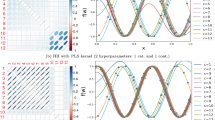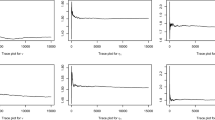Abstract
Recently, the research community in reliability analysis has seen a strong surge of interest in the dimension decomposition approach, which typically decomposes a multi-dimensional system response into a finite set of low-order component functions for more efficient reliability analysis. However, commonly used dimension decomposition methods suffer from two limitations. Firstly, it is often difficult or impractical to predetermine the decomposition level to achieve sufficient accuracy. Secondly, without an adaptive decomposition scheme, these methods may unnecessarily assign sample points to unimportant component functions. This paper presents an adaptive dimension decomposition and reselection (ADDR) method to resolve the difficulties of existing dimension decomposition methods for reliability analysis. The proposed method consists of three major components: (i) an adaptive dimension decomposition and reselection scheme to automatically detect the potentially important component functions and adaptively reselect the truly important ones, (ii) a test error indicator to quantify the importance of potentially important component functions for dimension reselection, and (iii) an integration of the newly developed asymmetric dimension-adaptive tensor-product (ADATP) method into the adaptive scheme to approximate the reselected component functions. The merits of the proposed method for reliability analysis are three-fold: (a) automatically detecting and adaptively representing important component functions, (b) greatly alleviating the curse of dimensionality, and (c) no need of response sensitivities. Several mathematical and engineering high-dimensional problems are used to demonstrate the effectiveness of the ADDR method.










Similar content being viewed by others
References
Alis OF, Rabitz H (2001) Efficient implementation of high dimensional model representations. J Math Chem 29(2):127–142
Au SK, Beck JL (1999) A new adaptive importance sampling scheme for reliability calculations. Struct Saf 21(2):135–158
Barthelmann V, Novak E, Ritter K (2000) High dimensional polynomial interpolation on sparse grids. Adv Comput Math 12(4):273–288
Breitung K (1984) Asymptotic approximations for multinormal integrals. ASCE J Eng Mech 110(3):357–366
Chowdhury R, Rao BN, Prasad AM (2009) High dimensional model representation for structural reliability analysis. Commun Numer Methods Eng 25(4):301–337
Eldred MS, Burkardt J (2009) Comparison of non-intrusive polynomial chaos and stochastic collocation methods for uncertainty quantification. In: Proceedings of the 47th AIAA aerospace sciences meeting, Orlando, FL
Eldred MS, Webster CG, Constantine P (2008) Design under uncertainty employing stochastic expansion methods. In: Proceedings of the 12th AIAA/ISSMO multidisciplinary analysis and optimization conference, Victoria, British Columbia, Canada
Foo J, Karniadakis GE (2010) Multi-element probabilistic collocation method in high dimensions. J Comput Phys 229:1536–1557
Foo J, Wan X, Karniadakis GE (2008) The multi-element probabilistic collocation method (ME-PCM): error analysis and applications. J Comput Phys 227:9572–9595
Fu G, Moses F (1988) Importance sampling in structural system reliability. In: Proceedings of ASCE joint specialty conference on probabilistic methods, Blacksburg, VA, pp 340–343
Ganapathysubramanian B, Zabaras N (2007) Sparse grid collocation schemes for stochastic natural convection problems. J Comput Phys 225(1):652–685
Gerstner T, Griebel M (1998) Numerical integration using sparse grids. Numer Algorithm 18(3–4):209–232
Grestner T, Griebel M (2003) Dimension-adaptive tensor-product quadrature. Computing 71(1):65–87
Ghanem RG, Spanos PD (1991) Stochastic finite elements: a spectral approach. Springer, New York
Griebel M (1998) Adaptive sparse grid multilevel methods for elliptic PDEs based on finite differences. Computing 61(2):151–179
Griebel M, Holtz M (2010) Dimension-wise integration of high-dimensional functions with applications to finance. J Complex 26(5):455–489
Hasofer AM, Lind NC (1974) Exact and invariant second-moment code format. ASCE J Eng Mech 100(1):111–121
Hu C, Youn BD (2011) An asymmetric dimension-adaptive tensor-product method for reliability analysis. Struct Saf 33(3):218–231
Hurtado JE (2007) Filtered importance sampling with support vector margin: a powerful method for structural reliability analysis. Struct Saf 29(1):2–15
Klimke A (2006) Uncertainty modeling using fuzzy arithmetic and sparse grids. PhD thesis, Universität Stuttgart, Shaker, Aachen
Kuo FY, Sloan IH, Wasilkowski GW, Wozniakowski H (2010) On decompositions of multivariate functions. Math Comput 79:953–966
Law AM, Kelton WD (1982) Simulation modeling and analysis. McGraw-Hill, New York
Lee SH, Chen W, Kwak BM (2009) Robust design with arbitrary distributions using Gauss-type quadrature formula. Struct Multidisc Optim 39(3):227–243
Li G, Rosenthal C, Rabitz H (2001a) High dimensional model representations. J Phys Chem A 105:7765–7777
Li G, Wang SW, Rabitz H (2001b) High dimensional model representations generated from low dimensional data samples—I: mp-Cut-HDMR. J Math Chem 30(1):1–30
Ma X, Zabaras N (2009) An adaptive hierarchical sparse grid collocation algorithm for the solution of stochastic differential equations. J Comput Phys 228(8):3084–3113
Ma X, Zabaras N (2010) An adaptive high-dimensional stochastic model representation technique for the solution of stochastic partial differential equations. J Comput Phys 229:3884–3915
Naess A, Leira BJ, Batsevych O (2009) System reliability analysis by enhanced Monte Carlo simulation. Struct Saf 31(5):349–355
Nobile F, Tempone R, Webster C (2008) A sparse grid collocation method for elliptic partial differential equations with random input data. SIAM J Numer Anal 46(5):2309–2345
Noh Y, Choi KK, Du L (2008) Selection of copula to generate input joint CDF for RBDO. In: Proceedings of ASME international design engineering technical conferences (IDETC) and computers and information in engineering conference (CIE), IDETC2008-49494, Brooklyn, New York, United States
Paffrath M, Wever U (2007) Adapted polynomial chaos expansion for failure detection. J Comput Phys 226(1):263–281
Rabitz H, Alis OF (1999) General foundations of high dimensional model representations. J Math Chem 25(2–3):197–233
Rabitz H, Alis OF, Shorter J, Shim K (1999) Efficient input–output model representations. Comput Phys Commun 117(1–2):11–20
Rahman S, Xu H (2004) A Univariate dimension-reduction method for multi-dimensional integration in stochastic mechanics. Probab Eng Mech 19(4):393–408
Rao BN, Chowdhury R (2009) Enhanced high dimensional model representation for reliability analysis. Int J Numer Methods Eng 77(5):719–750
Rosenblatt M (1952) Remarks on a multivariate transformation. Ann Math Stat 23:470–472
Roser BN (1999) An introduction to copulas. Springer, New York
Rubinstein RY (1981) Simulation and the Monte Carlo method. Wiley, New York
Smolyak S (1963) Quadrature and interpolation formulas for tensor product of certain classes of functions. Soviet Math Dokl 4:240–243
Sobol IM (2003) Theorems and examples on high dimensional model representations. Reliab Eng Syst Saf 79(2):187–193
Tvedt L (1984) Two second-order approximations to the failure probability. Section on structural reliability, A/S Vertas Research, Hovik, Norway
Wan X, Karniadakis GE (2006) Multi-element generalized polynomial chaos for arbitrary probability measures. SIAM J Sci Comput 28:901–928
Wei D, Rahman S (2007) Stuctural reliability analysis by univariate decomposition and numerical integration. Probab Eng Mech 22:27–38
Wiener N (1938) The homogeneous chaos. Am J Math 60(4):897–936
Xiong F, Greene S, Chen W, Xiong Y, Yang S (2010) A new sparse grid based method for uncertainty propagation. Struct Multidisc Optim 41(3):335–349
Xiu D (2007) Efficient collocational approach for parametric uncertainty analysis. Commun Comput Phys 2(2):293–309
Xiu D, Hesthaven JS (2005) High order collocation methods for the differential equation with random inputs. SIAM J Sci Comput 27(3):1118–1139
Xiu D, Karniadakis GE (2002) The Wiener–Askey polynomial chaos for stochastic differential equations. SIAM J Sci Comput 24(2):619–644
Xu H, Rahman S (2004) A generalized dimension-reduction method for multi-dimensional integration in stochastic mechanics. Int J Numer Methods Eng 61(12):1992–2019
Xu H, Rahman S (2005) Decomposition methods for structural reliability analysis. Probab Eng Mech 20:239–250
Youn BD, Wang P (2008) Bayesian reliability-based design optimization using eigenvector dimension reduction (EDR) method. Struct Multidisc Optim 36(2):107–123
Youn BD, Choi KK, Yi K (2005) Performance moment integration (PMI) method for quality assessment in reliability-based robust design optimization. Mech Base Des Struct Mach 33:185–213
Youn BD, Zhimin X, Wang P (2007) Reliability-based robust design optimization using the eigenvector dimension reduction (EDR) method. Struct Multidisc Optim 37(5):475–492
Youn BD, Zhimin X, Wang P (2008) Eigenvector dimension reduction (EDR) method for sensitivity-free uncertainty quantification. Struct Multidisc Optim 37(1):13–28
Acknowledgments
This work was partially supported by a grant from the Energy Technology Development Program (2010101010027B) and International Collaborative R&D Program (0420-2011-0161) of Korea Institute of Energy Technology Evaluation and Planning (KETEP), funded by the Korean government’s Ministry of Knowledge Economy, the National Research Foundation of Korea (NRF) grant (No. 2011-0022051) funded by the Korea government, the Basic Research Project of Korea Institute of Machinery and Materials (Project Code: SC0830) supported by a grant from Korea Research Council for Industrial Science & Technology, and the Institute of Advanced Machinery and Design at Seoul National University (SNU-IAMD).
Author information
Authors and Affiliations
Corresponding author
Rights and permissions
About this article
Cite this article
Hu, C., Youn, B.D. & Yoon, H. An adaptive dimension decomposition and reselection method for reliability analysis. Struct Multidisc Optim 47, 423–440 (2013). https://doi.org/10.1007/s00158-012-0834-0
Received:
Revised:
Accepted:
Published:
Issue Date:
DOI: https://doi.org/10.1007/s00158-012-0834-0




